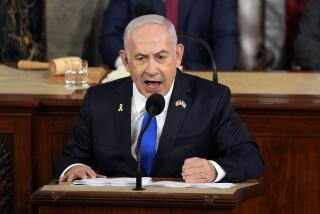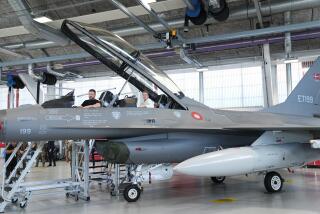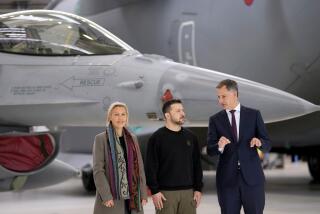Lockheed’s F-16 Hits Export Targets : With U.S Air Force orders curtailed, the versatile warplane has found new customers abroad. But competitors have the same territory in their sights.
CALABASAS — For 16 years, the banana-shaped profile of Lockheed Corp.’s F-16 “Fighting Falcon” has been the pride oS. fighter crews, who nickname the jets and scrub them spotless with orange-scented cleanser.
But the F-16’s days as an American emblem are waning. Although the U.S. Air Force has bought 2,000 of them--and recently dispatched 84 to the Persian Gulf in response to Iraqi troop movements--it is ending orders this year due to post-Cold War budget cuts.
So today, most new F-16s coming off Lockheed’s Fort Worth assembly line are destined for other countries. Over the years, 17 foreign countries, with U.S. approval, have bought the versatile, single-engine warplane. And overseas customers, including Singapore, Egypt, Portugal and Taiwan, now account for 90% of Lockheed’s impressive $11-billion F-16 backlog.
Some new foreign sales have been controversial, but they have helped make the F-16 one of Lockheed’s most profitable programs. Lockheed took over the F-16 project and the Fort Worth production plant from General Dynamics in March, 1993, and has since restructured its operations. The revenues from the Fort Worth plant are estimated by analysts at $3 billion per year, nearly 25% of Lockheed’s total sales. “The F-16 is a mature program. It no longer requires large investment, so it’s throwing off a lot of cash,” said Loren B. Thompson, a defense consultant and policy analyst.
Lockheed’s next-generation jet fighter, the F-22, which it is developing with the Boeing Co., won’t be delivered to the U.S. Air Force until 2004, if all goes well.
Given that lag, Lockheed is not about to let the F-16 market slip away. In its aggressive effort to keep the F-16 alive, the firm has laid off hundreds of workers to save costs, supplied both sides of an arms race between Greece and Turkey, pushed hard for new sales in developing countries like Chile, and agreed to transfer unprecedented levels of technology as part of a sale of planes to South Korea. The deal allowed South Korea to manufacture most of the plane itself.
Arms-control advocates say such an agenda heightens the risk of high-tech warfare in the developing world. With the Cold War over, the United States should seize its chance to limit global defense trade, said Lora Lumpe, director of the Washington, D.C.-based Arms Sales Monitoring Project of the Federation of American Scientists.
Others argue grimly that if the U.S. doesn’t sell fighter planes, Russia, Britain or some other country will. Political realism dictates that export limits focus on more lethal technology. “It’s the way it is,” said Kenneth Watman, researcher at the Rand Corp, adding, “That doesn’t mean I like it.”
From Lockheed’s point of view, the company is doing what it takes to make money in what has become an increasingly competitive international market for Cold War products. Joe Stout, a Lockheed spokesman, also argues that sales of American fighter planes allow for U.S. control of contract terms, training and spare parts.
Lockheed believes there’s a market for 500 to 800 new fighter aircraft worldwide in the next few years. But overall, the market for military hardware is constricted. U.S. foreign military sales dropped from a record high of $33.2 billion last year to $12.6 billion in fiscal 1994, according to the Pentagon.
Tooth-and-nail competition for foreign contracts pits Lockheed against other makers of fighter aircraft. These include Lockheed’s domestic rival, McDonnell Douglas Corp., which makes the F/A-18 “Hornet”, a fatter, twin-engine jet used by the U.S. Navy. McDonnell Douglas also makes the F-15 “Eagle” an air-combat fighter that costs about $50 million. Last year McDonnell Douglas won a major victory at Lockheed’s expense when it landed a $2-billion deal to build 21 new F-15s for Israel.
Lockheed is now vying with McDonnell Douglas again for a potential multibillion-dollar contract from the United Arab Emirates, which wants as many as 80 fighter planes. Experts say the contest is shaping into another highly competitive duel, with the likely result that the tiny gulf state will someday own planes as good as those of the U.S. Air Force.
Nor has Lockheed neglected the domestic market. The company is an enthusiastic backer of a Pentagon proposal dubbed a “high-tech yard sale” by Tom Cardamone, editor of Arms Trade News in Washington, D.C., and a critic of the plan. The Pentagon idea is to sell as many as 360 used F-16s abroad next year. Money raised would be spent on new F-16 Lockheed planes for the Air Force. Potential recipients are countries that would have trouble affording planes otherwise, such as the Philippines, Tunisia and Morocco.
If Congress signs off on the plan, Lockheed also stands to gain by doing modification work on the old F-16s before they are parceled out. Lockheed has also tried to get the Pentagon to buy a few more F-16s by reducing the price to $20 million per plane, down from about $23 million from its latest sale.
The versatility and low price of the F-16 has made it a valuable commodity. The jet is used for both bombing raids and dogfights, day or night. F-16s made one-quarter of the air strike sorties by the U.S. military against Iraq in 1991 and were deployed last spring against Bosnian Serbs.
Capt. Paul McIntosh, who flies an F-16 nicknamed “Wild Thang” out of Utah’s Hill Air Force Base, said the plane’s avionics and electronics are so advanced that the cockpit resembles a videogame, and is about as easy to use. Flying the plane “is like sitting on the edge of a magic carpet,” McIntosh said.
The single-seat F-16 is a 50-foot cylinder of smooth, gleaming metal with a pointy nose. Its fuselage is so slender that you could almost wrap your arms around it. At times, the F-16 has gotten too fancy for its own good: One version of the plane offered a steering stick so sensitive that it responded to the slightest pressure of the palm. Air Force pilots--who were used to less-sensitive parts--were unnerved, and eventually the device was retooled to allow a small amount of gratuitous motion.
Lockheed attributes the long life of the plane to continuous upgrades. Newer versions offer state-of-the-art radar technology and ever more powerful engines--all packed into a design that dates back to the ‘70s. Once, you could easily slide a fist in the space between the engine’s nozzle and the wall of the fuselage that contains it. Now, because the engine is so much bigger, you could barely squeeze a quarter between them.
Since Lockheed bought the F-16 program from General Dynamics, it has also introduced what the company calls “lean manufacturing” techniques. About 14,000 people work in the Forth Worth plant now, down from 31,000 five years ago, and Lockheed will bring that number down to 13,000 by the end of this year to reduce the cost of the F-16. Since it acquired the plant, Lockheed claims revenue earnings per employee have doubled.
The changes have not come without pain, however. In some cases, Lockheed workers who lost their jobs end up being hired back through subcontractors for lower pay, said John C. Crowdis, business representative for the local chapter of the International Assn. of Machinists and Aerospace Workers. The union is also angry about foreign production of F-16s. Workers protested when the company agreed to transfer some technology as part of its deal to allow South Korea to make the plane.
“We have had to make some tough decisions. . . . But the fact is it allows us to make sales that we wouldn’t make otherwise,” replied Stout, the Lockheed spokesman.
Neither exports nor foreign production of the F-16 are new. Assembly lines for portions of the fighter were set up in Belgium and the Netherlands for members of the North Atlantic Treaty Organization the same year the U.S. Air Force got is first delivery of the plane in 1978. Replacements and upgrades for longtime customers are still big business for Lockheed.
But over the years, the pool of foreign buyers has extended beyond NATO members to include Egypt, Indonesia, Bahrain and others. Foreign sales of the plane are conducted through the U.S. government. No American contractor can sell military equipment without State Department approval.
As F-16s have proliferated, they have surfaced in some odd places. Venezuela, which bought 24 of the planes in 1982, has used them to combat gold smugglers. The Turkish government is believed to have used F-16s to attack villages of Kurdish rebels.
Like Turkey, neighboring Greece has also sought renewed orders of F-16s from Lockheed. The purchases reflect, in part, “a simmering, low-level arms race” between the two, said William Hartung, senior research fellow at the World Policy Institute in New York. Hartung is critical of the Lockheed sales. Watman, the Rand expert, said it can’t be avoided. “I know this sounds cold, but would it make people feel better if we only sold them to Greece and the Turks bought (Russian-made) MIGs?”
F-16 sales have been a prickly matter between the U.S. and Pakistan. The U.S. interrupted delivery of the planes when a dispute flared over Pakistan’s nuclear program. Pakistan later stopped payments, and the Fort Worth plant eventually canceled 43 planes from its backlog. Another agreement in 1992 to sell 150 F-16s to Taiwan caused a rift between the U.S. and China.
Controversy over aircraft sales draws little comment from Lockheed. “These are foreign policy decisions and the (U.S.) government has their reasons for why they make these decisions,” said Stout.
Lockheed and other defense contractors are pressing Congress to be less restrictive of aircraft exports and provide more money to finance purchases for countries short on cash. Although the 1991 Persian Gulf War sparked outrage over worldwide sales of military technology, opposition has softened as the debate turned to preserving jobs, said Lumpe, of the Arms Control Monitoring Project. The defense industry “turned this argument away from instability and death and warfare. . . . They’ve made it like selling toaster ovens or anything else,” she said.
Jets to Go
Lockheed Corp.’s F-16 jet fighter was first introduced in 1978. The versatile plane remains a major source of revenue and Lockheed has an $11.2-billion backlog for 519 F-16 jet orders and service contracts. But U.S. Air Force purchases of F-16s are slated to dry up this year.
However, sales of the F-16 to foreign countries, with approval by the U.S. government, continues to be strong. In foreign markets, the single-engine F-16 competes increasingly against a twin-engine rival, the FA-18, made by McDonnell Douglas.
Here is a look at the sales of F-16 fighter jets worldwide. Foreign contract figures include both jets on order, and those already delivered.
Lockheed F-16 Fighter Jet Sales Overseas:
Bahrain: 12
Belgium: 160
Denmark: 70
Egypt: 174
Greece: 80
Indonesia: 12
Israel: 210
Netherlands: 213
Norway: 74
Pakistan: 68
Portugal: 20
Singapore: 26
South Korea: 160
Taiwan: 150
Thailand: 36
Turkey: 240
Venezuela: 24
Total F-16 sales to foreign countries: 1,729 jets
F-16 deliveries to U.S. Air Force: 2,151 jets
Source: Congressional Research Service, Washington D.C. and Lockheed.
More to Read
Inside the business of entertainment
The Wide Shot brings you news, analysis and insights on everything from streaming wars to production — and what it all means for the future.
You may occasionally receive promotional content from the Los Angeles Times.










